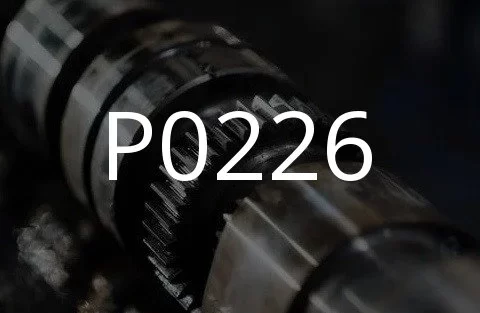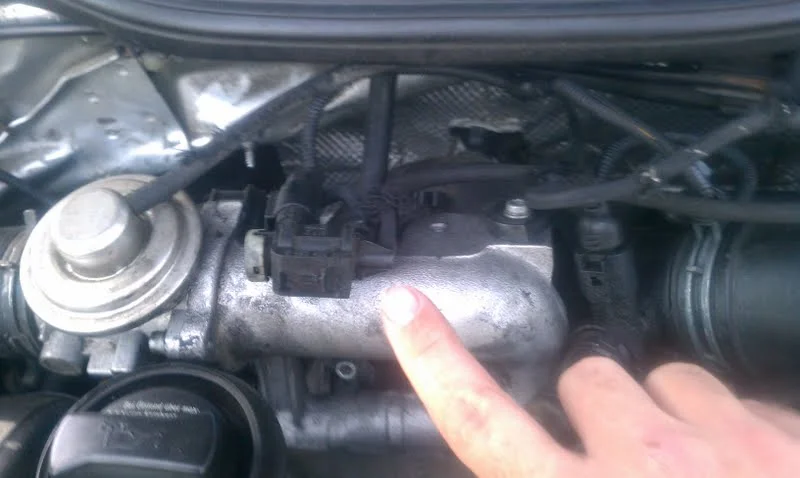
P0226 – Throttle Position/Accelerator Pedal Position Sensor “C” Signal Out of Range
Content
P0226 – OBD-II Trouble Code Technical Description
Trouble code P0226 indicates that the throttle position/accelerator pedal position sensor “C” signal level is out of range.
What does the fault code mean P0226?
Trouble code P0226 indicates a problem with the throttle position sensor (TPS) or its control circuit. Specifically, this code means that the signal level from the TPS sensor “C” (usually the second sensor on the engine) is outside the acceptable range. This may indicate that the TPS “C” sensor needs to be replaced or adjusted, and the associated wires and connectors should be checked for damage or corrosion.

Possible reasons
Several possible reasons for the P0226 trouble code:
- TPS sensor “C” malfunction: The TPS “C” sensor itself may be damaged, worn, or failing, resulting in an incorrect reading of the throttle position and resulting in a low signal level.
- Problems with wiring or connections: Wiring, connectors or connections associated with the TPS “C” sensor may be damaged, broken or corroded, interfering with the signal transmission from the sensor to the ECU (Electronic Control Unit).
- Incorrect installation or calibration of TPS “C” sensor: If the TPS “C” sensor has not been installed or configured correctly, it may result in erroneous signals.
- Problems with the throttle mechanism: A malfunctioning or stuck throttle mechanism can also cause P0226 because the TPS sensor measures the position of this throttle valve.
- External influences: Moisture or dirt entering the TPS “C” sensor or its connector can also cause a low signal level.
- ECU malfunction: It is rare but possible that the ECU (Electronic Control Unit) itself may have a defect or malfunction that causes the signal from the TPS “C” sensor to be low.
To accurately determine the cause of the P0226 code, it is recommended to conduct a thorough diagnosis of the engine management system. This may include checking the TPS “C” sensor, wiring, connectors, throttle body and ECU.
What are the symptoms of a fault code? P0226?
Some of the possible symptoms of trouble code P0226:
- Unstable engine operation: The vehicle may experience instability at idle or while driving. This may result in a rattling or rough idle, as well as intermittent jerking or loss of power when accelerating.
- Acceleration issues: The engine may respond slowly or not at all to throttle input due to misreading of the throttle position.
- Power limitation: In some cases, the vehicle may enter a limited power mode or limp mode to prevent further damage or accidents.
- Error or warning on the instrument panel: The driver may see an error or warning on the instrument panel indicating a problem with the throttle position sensor.
- Increased fuel consumption: Incorrect reading of the throttle position can result in uneven fuel delivery, which increases consumption.
- Shifting problems (automatic transmission only): Automatic transmission vehicles may experience jerky or abnormal gear shifting due to an unstable signal from the throttle position sensor.
If you experience these symptoms and see the P0226 code, it is recommended that you contact a professional auto mechanic to diagnose and fix the problem.
How to diagnose a fault code P0226?
To diagnose DTC P0226, the following steps are recommended:
- Check the error code: Using an OBD-II scanner, read the P0226 error code. This will give you some initial information about what exactly might be the problem.
- Visual inspection: Inspect the wiring and connectors associated with the throttle position sensor “C”. Look for damage, corrosion, or broken wires.
- Check voltage and resistance: Using a multimeter, measure the voltage at the throttle position sensor “C” output terminals. The voltage level must be within the manufacturer's specifications. Also check the sensor resistance.
- Check TPS sensor “C”: Check the operation of the throttle position sensor “C”. This can be done using a multimeter by measuring the change in resistance as you change the throttle position. It may also be necessary to check the angular position of the TPS sensor using a special scanner or multimeter.
- Check the throttle mechanism: Make sure the throttle mechanism moves freely and is not stuck. Also check the condition and functionality of the throttle valve drive mechanism.
- Check the ECU (electronic control unit): If everything else is ok but the problem persists, the ECU itself may need to be diagnosed. This requires special equipment and experience, so in this case it is better to turn to professionals.
- Check other engine management system components: Certain other engine management system components, such as the manifold absolute pressure (MAP) or mass air flow (MAF) sensors, can also affect the operation of the TPS “C” sensor.
After completing these steps, you will be able to determine the cause of the P0226 code and begin troubleshooting it. If you do not have the experience or necessary equipment to perform a diagnosis, it is recommended that you contact a professional auto mechanic.
Diagnostic errors
When diagnosing DTC P0226, the following errors may occur:
- Misinterpretation of data: One of the most common types of errors is the incorrect interpretation of the data received from the throttle position sensor (TPS) “C”. Incorrect reading or interpretation of this data may lead to an incorrect determination of the cause of the error.
- Skipping Wiring and Connector Checks: Sometimes mechanics may skip a thorough check of the wiring and connectors associated with the TPS “C” sensor. Damaged wiring or poor connections in the connectors can be the cause of the P0226 code, so you need to pay attention to this.
- Incorrect diagnosis of TPS sensor: Diagnosis of the TPS sensor must be thorough and methodical. Incorrectly identifying the problem or skipping important steps during testing may result in the problem not being corrected correctly.
- Skipping throttle mechanism check: Sometimes mechanics may skip checking the throttle body itself and its operating mechanism. Damaged or stuck throttle mechanism can also cause P0226.
- Incorrect component replacement: When diagnosing the P0226 error, there may be an error in selecting replacement components. For example, incorrectly replacing the TPS “C” sensor may not correct the problem if the source of the problem is located elsewhere.
- Hardware or software problems: Incorrect use or malfunction of the diagnostic equipment used, as well as incorrect or outdated software versions may lead to incorrect diagnosis of the error.
- Wrong decision: Sometimes the mechanic may make the wrong decision regarding what steps to take to fix the problem. For example, skip checking other components that may be associated with the P0226 code.
- ECU problems: Error P0226 can also be associated with a malfunction of the ECU (electronic control unit) itself, which requires additional diagnostics.
To prevent errors when diagnosing the P0226 code, it is important to follow a methodical approach that includes thoroughly checking all possible causes and correctly interpreting the data obtained.
How serious is the fault code? P0226?
Trouble code P0226, which indicates an abnormal signal level from the throttle position sensor “C”, is serious because it can cause the engine to malfunction and limit the functionality of the vehicle. A few reasons why this code is serious:
- Loss of engine control: A low signal from the throttle position sensor can cause loss of engine control. This may manifest itself in the form of engine roughness, jerking when accelerating, or even loss of power.
- Performance limitation: Incorrect operation of the throttle position sensor “C” may result in limited engine performance. The vehicle may enter a power-limited mode, which will reduce acceleration and limit driving speed.
- Increased fuel consumption: Incorrect operation of the TPS sensor can result in uneven fuel delivery, which can lead to increased fuel consumption and, as a result, additional refueling costs.
- Transmission damage: On vehicles with automatic transmission, incorrect operation of the TPS sensor can cause incorrect shifting and wear on the transmission.
- Danger on the road: Unpredictable engine operation due to the P0226 code can create dangerous situations on the road for both the driver and surrounding road users.
Based on the above factors, trouble code P0226 should be taken seriously. Immediate troubleshooting and repairs are necessary to restore normal engine operation and ensure safety on the road.
What repair will help eliminate the code? P0226?
Troubleshooting trouble code P0226 (throttle position sensor “C” abnormal signal level) depends on the specific cause of the problem. Several possible actions that can help resolve this error:
- Replacing the Throttle Position Sensor (TPS) “C”: If the TPS sensor “C” fails or gives an incorrect signal, it must be replaced. Typically the TPS sensor is sold with the throttle body, but sometimes it can be purchased separately.
- Checking and replacing wiring and connectors: The wiring and connectors associated with the TPS “C” sensor should be carefully inspected for damage, corrosion, or breaks. If problems are found, the wiring and connectors must be replaced or repaired.
- Calibration of the new TPS “C” sensor: After replacing the TPS “C” sensor, it must be properly calibrated to ensure correct operation of the engine management system. This may include a calibration procedure described in the manufacturer's technical documentation.
- Checking and replacing the accelerator pedal position sensor: In some cases, the problem may not only be with the TPS sensor, but also with the accelerator pedal position sensor. If this is the case, the accelerator pedal position sensor should also be checked and, if necessary, replaced.
- Diagnostics and updating of ECU firmware: In some cases, the problem may be due to incompatibility or errors in the ECU firmware. In this case, diagnostics and updating of the ECU firmware may be required.
- Checking the throttle valve: Check the condition and functionality of the throttle mechanism. Make sure it moves freely and does not bind.
- Checking and fixing other problems: If the problem persists after replacing the TPS “C” sensor, there may be other problems such as problems with the ECU (Electronic Control Unit), wiring or throttle body. These problems must also be detected and corrected.
After repairs and component replacements are completed, it is recommended that the engine management system be tested using an OBD-II scanner to ensure that the P0226 code no longer appears and all systems are operating correctly.
P0226 – Brand-specific information
The P0226 fault code may have different meanings depending on the vehicle manufacturer; here are the P0226 codes for some specific brands:
- Toyota / Lexus: Throttle/Pedal Position Sensor/Switch “C” Circuit Performance.
- Honda/Acura: Throttle/Pedal Position Sensor/Switch “C” Circuit Range/Performance Problem.
- Nissan/Infiniti: Throttle/Pedal Position Sensor/Switch “C” Circuit Range/Performance Problem.
- Ford: Throttle/Pedal Position Sensor/Switch “C” Circuit Range/Performance Problem.
- Chevrolet / GMC: Throttle/Pedal Position Sensor/Switch “C” Circuit Range/Performance Problem.
- Volkswagen / Audi / Skoda / Seat: Throttle/Pedal Position Sensor/Switch “C” Circuit Range/Performance Problem.
- BMW/Mini: Throttle/Pedal Position Sensor/Switch “C” Circuit.
- Mercedes-Benz: Throttle/Pedal Position Sensor/Switch “C” Circuit Range/Performance Problem.
These are only general descriptions and additional diagnostics may be required to accurately determine the problem and resolve the malfunction. If you experience a P0226 code, it is recommended that you consult your vehicle's service book or a professional auto mechanic for an accurate diagnosis and repair.

One comment
Jean-Louis
Hello, on a 3 laguna 2012 coupé, I have the code P0226 which has been coming back regularly for a few days since 2015.
Recently, I cleaned the printed circuit located in the accelerator pedal unit in the passenger compartment, but after a few weeks the “injection to be checked” light came back.
Even if this is not yet penalizing except for the intermittent error message and rather in the summer, I would like to find the origin of the failure.
Sincerely.